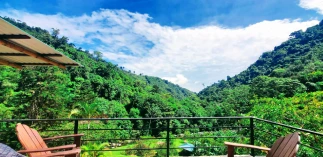Costa Rica stands as one of the most inspiring examples of how sustainable tourism Costa Rica supports both economic development and environmental protection. The nation has transformed its natural wealth—lush rainforests, diverse wildlife, and pristine beaches—into a source of livelihood while maintaining its deep commitment to ecological preservation. Its model of balancing tourism with conservation demonstrates that economic progress and environmental responsibility can grow hand in hand.
The Foundation of Costa Rica’s Eco-Conscious Vision
Costa Rica’s approach to tourism stems from its national philosophy of sustainability. Nearly 30% of the country’s land is under protection, encompassing national parks, biological reserves, and wildlife refuges. This deliberate protection ensures that tourism growth does not come at the expense of biodiversity.
The government, in collaboration with local communities, developed policies that prioritize renewable energy, waste management, and habitat restoration. Visitors are encouraged to respect these practices, creating a culture where travelers become allies in conservation efforts rather than threats to them.
How Conservation Shapes the Tourism Landscape?
Tourism in Costa Rica is not about mass development; it’s about experiences that respect and enhance the natural environment. Instead of building towering resorts and crowded beaches, the country promotes eco-lodges, small sustainable hotels, and community-based tourism. These enterprises follow eco-friendly construction principles, use solar power, and recycle waste wherever possible.
By preserving rainforests, coral reefs, and mountain ranges, Costa Rica ensures that visitors can experience authentic nature. Conservation efforts are not isolated from tourism—they are at the heart of the tourism product itself.
National Parks: The Core of the Coexistence Model
Costa Rica’s national parks are living examples of how tourism and conservation merge seamlessly.
- Manuel Antonio National Park offers guided nature walks that help visitors spot sloths, monkeys, and exotic birds, while maintaining strict visitor limits to prevent ecosystem strain.
- Corcovado National Park, one of the most biodiverse places on the planet, restricts entry numbers to ensure minimal human impact.
- Tortuguero National Park protects vital nesting grounds for sea turtles, while regulated tours support both local economies and conservation funding.
Each park generates tourism revenue that directly supports protection programs, infrastructure maintenance, and education initiatives for local communities.
Community Involvement in Conservation Efforts
One of the keys to Costa Rica’s success lies in empowering local communities. Rather than excluding residents from protected areas, the government and NGOs integrate them into the tourism economy. Many locals serve as park rangers, tour guides, and eco-lodge operators. Their deep-rooted connection to the land enriches visitor experiences and ensures that profits stay within the community.
This involvement transforms conservation from a government mandate into a shared cultural value. Communities see direct benefits from protecting the environment, which fosters long-term stewardship of natural resources.
The Role of Ecotourism
Ecotourism represents the backbone of Costa Rica’s tourism strategy. Unlike traditional tourism models that can exploit resources, ecotourism promotes low-impact travel that funds preservation. Visitors participate in activities that protect the very ecosystems they come to admire—tree planting, beach cleanups, and wildlife monitoring.
The country’s certification program for sustainable tourism evaluates businesses on environmental management, cultural respect, and community contribution. This ensures that eco-practices remain transparent and measurable rather than symbolic gestures.
Wildlife Protection Through Responsible Tourism
Costa Rica’s thriving biodiversity attracts millions of nature enthusiasts each year. From toucans to tapirs, from jaguars to red-eyed tree frogs, the nation’s wildlife is a major draw. However, tourism activities are closely regulated to minimize stress on animals.
Rules include:
- No direct feeding or handling of wildlife
- Limited group sizes for nature tours
- Designated viewing zones and trails
- Prohibition of flash photography in sensitive areas
Such measures guarantee that wildlife remains undisturbed while still allowing visitors to appreciate their natural behaviors.
Education as a Conservation Tool
Education plays a crucial role in sustaining this harmony. Tour guides undergo training programs that combine natural science with cultural heritage. Schools emphasize environmental education from an early age, nurturing future generations that view conservation as second nature.
Visitors also become part of this educational chain. Interpretive centers, visitor programs, and informational signage in parks teach travelers about endangered species, ecosystems, and conservation success stories.
Renewable Energy and Eco-Infrastructure
Costa Rica’s commitment to conservation extends beyond forests. The country is a pioneer in renewable energy, generating over 98% of its electricity from clean sources like hydropower, wind, and geothermal energy.
Tourism businesses follow suit by:
- Installing solar panels and rainwater collection systems
- Using biodegradable products
- Implementing composting programs
- Promoting zero-plastic initiatives
Such practices reduce the carbon footprint of travel and align hospitality services with national sustainability goals.
Challenges in Maintaining the Balance
While Costa Rica has achieved remarkable progress, maintaining balance is not without challenges. Increased visitor numbers can strain fragile ecosystems, while infrastructure development risks encroaching on natural habitats. Illegal hunting, pollution, and climate change also pose threats to biodiversity.
The government continuously refines policies to manage visitor flow, enforce conservation laws, and promote off-season travel to reduce pressure on popular sites. Balancing accessibility and preservation remains an ongoing process requiring constant vigilance.
Private Reserves: A Complement to Public Conservation
Private landowners have become essential allies in expanding protected territories. Many establish private wildlife refuges that complement the national park system. These areas often offer guided hikes, research facilities, and reforestation programs.
Private conservation efforts create biological corridors that connect fragmented habitats, ensuring safe migration routes for species and maintaining genetic diversity.
Reforestation: Restoring What Was Lost
Costa Rica once suffered extensive deforestation during the mid-20th century. Recognizing the ecological and economic cost, the nation launched reforestation initiatives that reversed the damage.
Government incentives, such as payments for ecosystem services, encouraged landowners to plant trees and preserve forests. Reforestation not only restored habitats but also enhanced the tourism appeal of the country’s landscapes.
Cultural Conservation and Indigenous Involvement
Conservation in Costa Rica is not limited to nature—it includes cultural heritage as well. Indigenous communities like the Bribri and Boruca play a vital role in preserving ancestral traditions and ecological knowledge.
Their crafts, organic farming methods, and sustainable lifestyles attract visitors interested in authentic cultural experiences. This cultural conservation complements natural conservation, creating a more holistic form of sustainability.
Marine Conservation and Coastal Tourism
Costa Rica’s coastal regions, from the Pacific to the Caribbean, highlight how marine ecosystems can coexist with tourism. Coral reefs, mangroves, and turtle nesting sites receive strong legal protection.
Eco-certified diving operations, sustainable fishing programs, and community-led beach patrols help safeguard marine life. These initiatives also provide employment opportunities in coastal communities, ensuring that ocean health directly supports local prosperity.
The Economic Value of Conservation
Protecting nature has proven to be not just environmentally sound but economically beneficial. Tourism contributes a significant share of Costa Rica’s GDP, yet this growth relies on maintaining pristine ecosystems.
Revenue from entrance fees, eco-lodges, and sustainable activities funds education, infrastructure, and further conservation. In essence, protecting the environment sustains the very economy that depends on it.
Technological Innovation in Sustainability
Costa Rica integrates technology into its conservation efforts. Drone mapping, wildlife tracking apps, and digital monitoring systems help researchers study animal migration and detect illegal activities.
Hotels use smart energy systems to regulate consumption, while digital platforms promote eco-friendly transportation options like electric shuttles and bicycles. Technology strengthens the connection between efficiency and environmental care.
Supporting Local Economies Through Green Enterprises
Eco-friendly tourism has fostered a wave of green entrepreneurship. Locals have established organic farms, sustainable coffee plantations, and artisan markets that appeal to environmentally conscious travelers.
These enterprises:
- Reduce dependence on large-scale, resource-heavy industries
- Provide stable income for rural populations
- Encourage innovation in waste reduction and recycling
By supporting local producers, visitors contribute directly to community welfare and conservation funding.
Sustainable Travel Practices for Visitors
Travelers play a crucial role in maintaining the coexistence between tourism and conservation. Responsible behaviors amplify the impact of national policies and local efforts.
Key practices include:
- Staying in certified eco-lodges
- Using reusable bottles and bags
- Respecting wildlife and keeping a safe distance
- Participating in local conservation programs
- Choosing eco-certified tour operators
Every small decision made by visitors helps preserve Costa Rica’s delicate ecological balance.
Measuring Success: Indicators of Balance
Costa Rica’s success can be measured through tangible outcomes:
- Reforested land has increased significantly in the past decades.
- Wildlife populations are rebounding in protected areas.
- Energy consumption is predominantly renewable.
- Local communities report higher incomes from sustainable ventures.
- Environmental awareness among citizens and travelers continues to grow.
These indicators reflect a living system that evolves with responsibility and vision.
The Future of Tourism and Conservation in Costa Rica
Costa Rica continues to refine its model, serving as inspiration for other nations. The next frontier involves climate adaptation, digital conservation tools, and expanded community participation.
By maintaining its focus on nature-based solutions, transparent governance, and responsible travel, Costa Rica reinforces the truth that conservation and tourism are not opposing forces—they are partners in sustaining life and livelihoods.
Conclusion
The coexistence of tourism and conservation in Costa Rica proves that prosperity need not come at the cost of nature. Through policy, participation, and passion for the environment, the country has achieved a rare equilibrium—one that nourishes both people and the planet. Costa Rica’s story reminds us that when nature thrives, humanity thrives alongside it.







